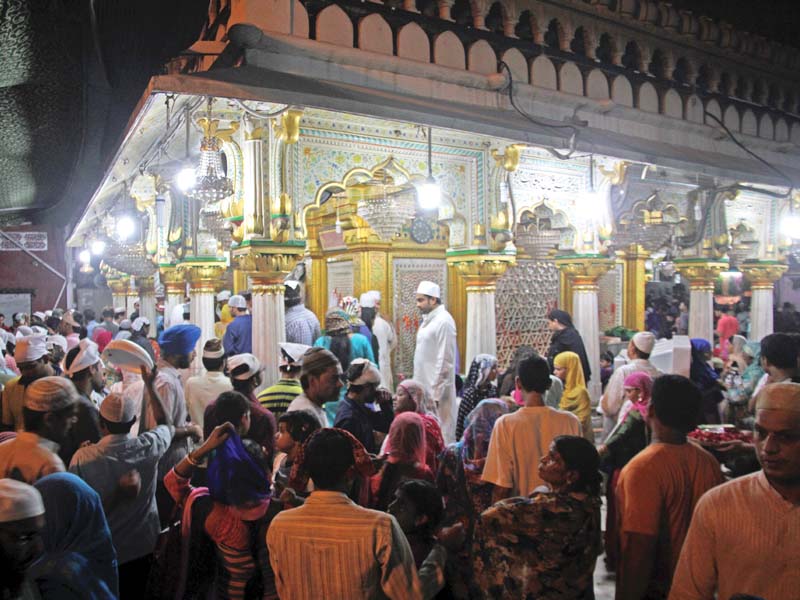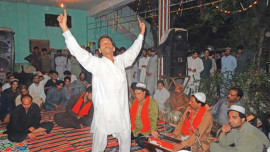
As the evening stretches its arms over the skyline in the vibrant city of New Delhi, the historical Basti Nizamuddin comes back to life. Groggy with the day’s ordeal, the rest of the city hits the sack early. Unlike other localities, the Basti Nizamuddin is buzzing.
Thursday nights at the towering mystic Hazrat Nizamuddin Auliya’s shrine are quite an affair. “Thursdays are special. They are qawwali nights,” says 23-year-old Rashid Nizami, as he navigates through the narrow street that leads to the large, airy compound.
Although the neighbourhood lies on the outskirts of Old Delhi, when it comes to the Sub-continent’s cultural thrust, it is right in the heart of the matter. Hundreds of devotees have already begun to emerge from the doorway to the place that symbolises humanity and tolerance.
Read: A divine rhythm

As the qawwals whisper to each other, Khusru’s own shrine watches them over from right across Nizamuddin’s. PHOTO: ATHAR KHAN/EXPRESS
NIzamuddin is no ordinary mystic. He is known to have survived several reigns in the city that has been at the helm of power in the region for several centuries running. “Here is where these people learn about the Almighty,” adds Syed Nizam Ali Nizami, the shrine’s proud caretaker.
With the light gleaming in his face, the bearded man who appears to be in his 60s, oversees fellow caretakers scurrying in and out as they give final touches to the arrangements. Donning a white kurta pajama and an identical cap, Nizami explains his relation with Nizamuddin. “The saint never married. I am a descendant of his sister. We are all khadims [servants] who have been serving him for the last 700 years,” he adds, continually saying zikr on his rosary.

Syed Nizam Ali Nizami oversees fellow caretakers scurrying in and out as they give final touches to the arrangements.
Inside the white marbled structure, lies the saint burried. His grave is strewn with rose petals that have been scattered over green sheets. The light emerging from the building is evident.
The windows to the room are enmeshed in threads tied by the devotees who made wishes at the shrine. Once the wish is answered, the follower is bound to return, untie the thread and make some offering in the name of Nizamuddin.
Facing the shrine, Tahir Ali, Mahir Ali and Shakir Ali sit on the cool, naked marble floor with their nervous hands playing the instruments. The Pakistani qawwals are here for their moment to shine. Their musicians are almost ready.
The session will open with a famous eulogy penned by Hazrat Ameer Khusru. Khusru was the galactic understudy of Nizamuddin; a musician, a poet and a great mystic himself. “Qawwali is something that touches the soul. It moves the heart through its own language,” the lead singer Tahir tells The Express Tribune.

The windows to the room are enmeshed in threads tied by the devotees who made wishes at the shrine.
As the qawwals whisper to each other, Khusru’s own shrine watches them over from right across Nizamuddin’s. “When people listen to qawwali, it transports them to another world where they experience oneness with the Creator,” Tahir carefully adds.
Amongst the many trades of Khusru was qawwali, which he not only invented but developed for as long as he lived. Qawwali is literally in the air of this compound.
“This is where qawwali was born,” says Nizami as he returns after completing a chore. “When Nizamuddin started preaching Islam, the locals were attracted towards other religions whose integral part was singing and playing music. That’s the time when Khusru wove devotional poetry into classical compositions,” he explains.
Khusru is believed to have not only given birth to the tradition ragas, but also several instruments that changed Indian classical music forever.
“It is the devotion that has made qawwali immortal,” says popular qawwal Chand Nizami who lives nearby. His ancestors have been singing at the shrine for centuries and Chand is proud to uphold the legacy.
It is perhaps the very message of these mystics that transcends religious, social and communal demarcation; the message that continues to entice devotees from across the globe. As the qawwals tune their instruments and clear their throats, in a blink the crowd gathers around them, poised and silent; waiting to embark on a journey that continues to help wanderers to their destinations.
The writer is a staff correspondent who visited India as part of a journalism exchange program organised by the East West Center.
The story is the first of a two-part series revolving around the revival of qawwali in New Delhi. The second story will be published on the following Friday.
Published in The Express Tribune, September 25th, 2015.
Like Life & Style on Facebook, follow @ETLifeandStyle on Twitter for the latest in fashion, gossip and entertainment.




































COMMENTS (3)
Comments are moderated and generally will be posted if they are on-topic and not abusive.
For more information, please see our Comments FAQ